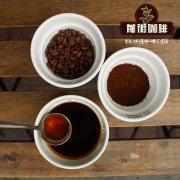Introduction to the History of planting characteristics in San Marcos Coffee producing area of Guatemala description of flavor and taste of Guatemalan coffee

Guatemala is famous for producing high-quality coffee. It has one of the most diverse climates in the world and is rich in volcanic soil, making it very suitable for coffee cultivation. There are eight coffee-producing regions in Guatemala, of which San Marcos has the oldest history, abundant rainfall and warm climate. Let's take a look at the area, the general situation of its coffee and the common processing methods.

The microclimate zone is in the mountains of the western part of the country, and San Marcos is known in Guatemala as "the place where the volcano wakes up". It is home to Tajumulco, the highest volcano in Central America, and several other volcanoes. The hilly landform and the influence of water vapor from the Pacific Ocean create a pleasant microclimate. San Marcos (San Marcos) has two of the highest volcanoes in Guatemala, the southern Pacific coast and the Sierra Madre de Chiapas Mountains (Sierra Madre de Chiapas), which makes the region unique in all climates. The rainy season begins here, arrives in mid-April and lasts until mid-November. This means that coffee plants bloom faster than in other areas. The humidity in San Marcos is between 70 and 80%, and the altitude is between 4600 and 6000m. Coffee planting area between 1300 and 1800 meters the unique acidity of San Marcos coffee comes from the region's coffee has obvious acidity and good body soft floral aroma. Compared with coffee from Vivette Nango and Antigua, coffee from San Marcos is often overlooked. However, due to the region's high altitude, abundant rainfall and centuries of rich mineral content in the soil of volcanic ash, coffee in the San Marcos area is famous for its unique acidity. Coffee from San Marcos (San Marcos) has a delicate floral aroma and taste, thanks to the influence of the Pacific and the region's unique microclimate. The coffee varieties grown in San Marcos include boutique beans from Bourbon, Kaddura and Kaduai, as well as commercial coffee beans such as Robusta, Vera Saatchi and Icato.

Coffee production and processing in San Marcos is the same as in most parts of Guatemala, and coffee farms in San Marcos are small. Hand-picked coffee is the standard here. According to Anacaf é 's Green Paper (Green Book), 98% of Guatemala's coffee is shady, and most of the coffee here is washed Arabica coffee. The processing after washing highlights the acidity of coffee. Planting in the shade can make it ripen more slowly and produce sweeter, more complex flavors. It also supports more diverse ecosystems.

Most of the producers we work with focus on growing cool, fully washed coffee. The coffee we buy from two major producers in the region focuses on using local springs to de-pulp the coffee and then drying it on the terrace or in a low-heat dryer, depending on the duration of the rainy season. Rainfall is unpredictable during the harvest season, so it is normal for producers here to dry coffee in a mechanical dryer. Guatemala also has a small number of other types of processing. Although tanned and honey-treated coffee in Guatemala is not as popular as in Central American countries such as Costa Rica, it does stand out from the cup, showing the aroma of pineapple and blueberries. Qianjie Coffee predicts that these types of treatments will become more popular.
Important Notice :
前街咖啡 FrontStreet Coffee has moved to new addredd:
FrontStreet Coffee Address: 315,Donghua East Road,GuangZhou
Tel:020 38364473
- Prev

How to choose the right temperature for hand-brewed coffee? why does it turn sour when it cools?
Have you ever enjoyed a cup of hot coffee, but noticed that once it starts to cool, its taste and aroma seem to change? When this happens, you may begin to discover delicate and subtle flavors and aromas that you could not detect before. You may find that your coffee now has obvious sweetness, fruity or floral aroma. The change in taste is caused by temperature fluctuations.
- Next

Why is the Lion King of Sidamo called this name? what's the difference between the flavor of the Lion King and Yega Xuefei?
Origin: Sidamo Guji processing plant: Shilicho Cooperative altitude: 1800-2000m bean seed: Heirloom treatment: sun treatment harvest method: manual harvest baking degree: medium-shallow baking flavor features: sweet blueberry aromas with lemon aromas, rich flower and fruit aromas, peach fruit honey aromas with surprisingly bright acidity and full berry aromas
Related
- Detailed explanation of Jadeite planting Land in Panamanian Jadeite Manor introduction to the grading system of Jadeite competitive bidding, Red bid, Green bid and Rose Summer
- Story of Coffee planting in Brenka region of Costa Rica Stonehenge Manor anaerobic heavy honey treatment of flavor mouth
- What's on the barrel of Blue Mountain Coffee beans?
- Can American coffee also pull flowers? How to use hot American style to pull out a good-looking pattern?
- Can you make a cold extract with coffee beans? What is the right proportion for cold-extracted coffee formula?
- Indonesian PWN Gold Mandrine Coffee Origin Features Flavor How to Chong? Mandolin coffee is American.
- A brief introduction to the flavor characteristics of Brazilian yellow bourbon coffee beans
- What is the effect of different water quality on the flavor of cold-extracted coffee? What kind of water is best for brewing coffee?
- Why do you think of Rose Summer whenever you mention Panamanian coffee?
- Introduction to the characteristics of authentic blue mountain coffee bean producing areas? What is the CIB Coffee Authority in Jamaica?

